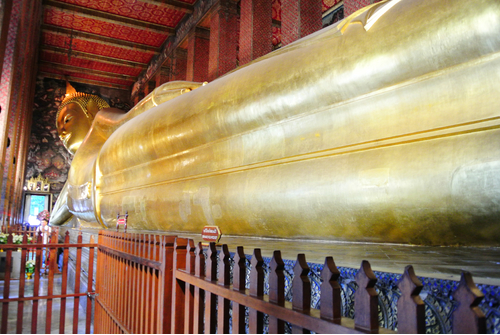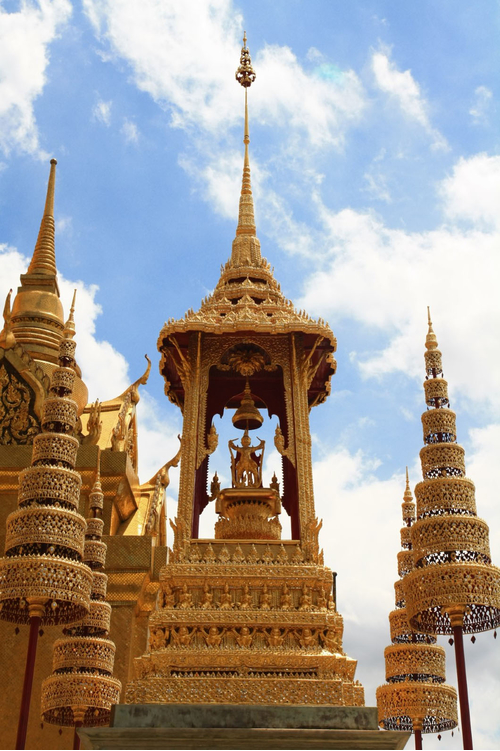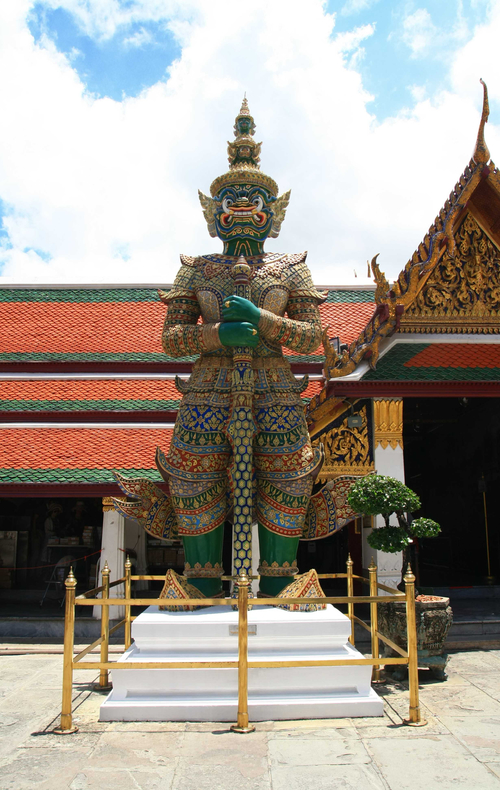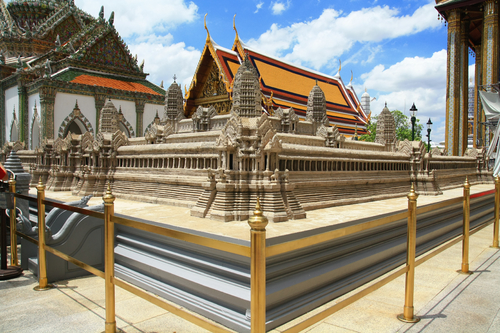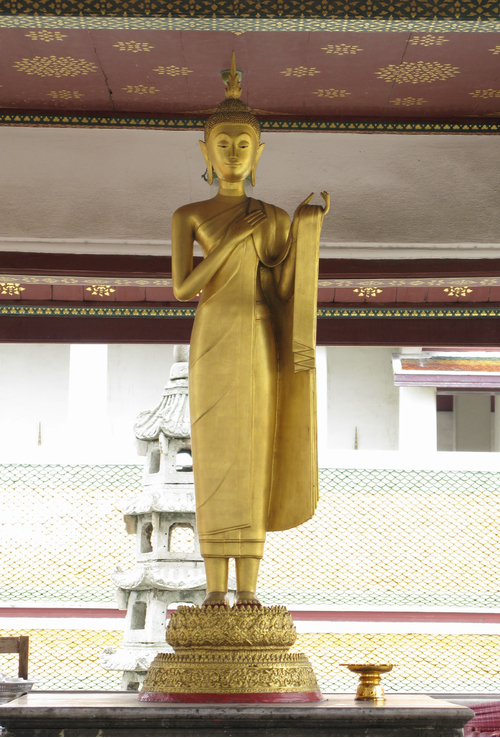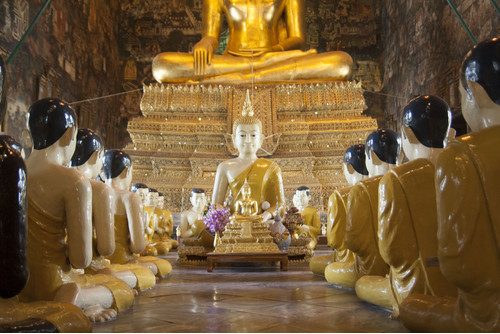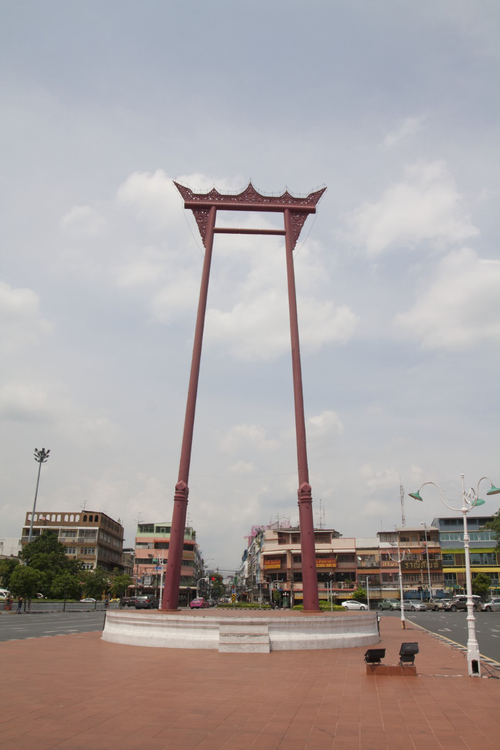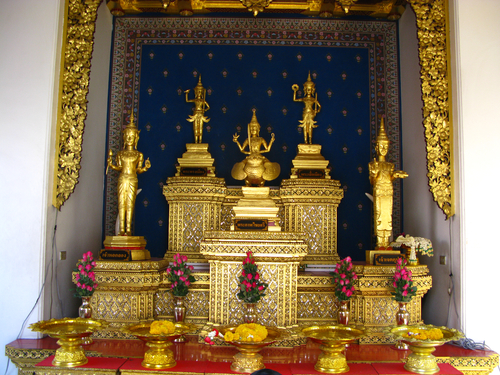ค้นหางานศิลปกรรม
ฐานข้อมูลศิลปกรรมในเอเชียตะวันออกเฉียงใต้
ประติมากรรมพระพุทธไสยาส, พระพุทธไสยาสน์
พระพุทธรูปประทับนอนตะแคงขวาหรือสีหไสยาสน์ พระหัตถ์ขวาตั้งขึ้นรองรับพระเศียร โดยมีพระเขนยทรงสี่เหลี่ยมประดับลวดลายดอกไม้อิทธิพลศิลปะจีนรองรับอีกทีหนึ่ง พระพุทธรูปมีรูปแบบเป็นศิลปะรัตนโกสินทร์ กล่าวคือ พระพักตร์สงบนิ่ง พระเนตรเหลือบต่ำ พระขนงโก่ง พระโอษฐ์บางเรียว พระกรรณยาว ขมวดพระเกศาขนาดเล็ก มีอุษณีษะ และพระรัศมีเป็นเปลวเพลิง ครองจีวรห่มเฉียงเรียบ ไม่มีริ้ว จีวรบางแนบพระวรกาย มีชายสังฆาฏิเป็นแถบสี่เหลี่ยม ปลายเป็นเขี้ยวตะขาบ พาดจากพระอังสาซ้ายมาที่กลางพระอุระ ยาวจรดกึ่งกลางพระนาภี สบงมีแถบสี่เหลี่ยมยาวที่ด้านหน้าจรดข้อพระบาท และมีขอบรัดประคดฝ่าพระบาททั้ง 2 ข้าง ประดับมุกลวดลายมงคล 108 ประการ แบ่งประเภทต่างๆ ได้ดังนี้1. สัญลักษณ์แห่งโชคลาภและความอุดมสมบูรณ์ เช่น หม้อน้ำ ปลาคู่ สวัสดิกะ พวงมณี ดอกบัว เป็นต้น2. เครื่องประกอบพระบารมีของกษัตริย์และพระเจ้าจักรพรรดิ เช่น รัตนะ 7 ประการ เครื่องราชกกุธภัณฑ์ บัลลังก์ เครื่องสูง เครื่องยศ เครื่องต้นต่างๆ และราชพาหนะ เป็นต้น 3. ภาพสัญลักษณ์ภูมิในจักรวาลตามความเชื่อของพระพุทธศาสนา เช่น เขาจักรวาล มหาสมุทร ทวีปทั้ง 4 เขาพระสุเมรุ เขาสัตตบริภัณฑ์ ป่าหิมพานต์ เป็นต้น
ประติมากรรมพระบรมราชสัญลักษณ์ประจำรัชกาล
บุษบกทุกองค์ทำด้วยโลหะปิดทองประดับกระจก มีลักษณะเป็นบุษบกโถง ประกอบด้วยเสาย่อมุมทั้ง 4 มุม รับเครื่องหลังคาที่เป็นยอดแหลม ซุ้มสาหร่ายทุกด้านออกลายเทพนม ส่วนฐานบุษบกประดับชั้นเทพนมบุษบกด้านทิศเหนือประดิษฐานพระบรมราชสัญลักษณ์รัชกาลที่ 1-3 ดังนี้พระบรมราชสัญลักษณ์พระบาทสมเด็จพระพุทธยอดฟ้าจุฬาโลกมหาราช เป็นรูปพระมหามงกุฎไม่มีกรรเจียก พระบรมราชสัญลักษณ์พระบาทสมเด็จพระพุทธเลิศหล้านภาลัย เป็นรูปครุฑยุดนาค พระบรมราชสัญลักษณ์พระบาทสมเด็จพระนั่งเกล้าเจ้าอยู่หัวเจ้าอยู่หัว เป็นรูปพระวิมาน บุษบกด้านทิศใต้องค์หนึ่งประดิษฐานพระบรมราชสัญลักษณ์ พระบาทสมเด็จพระจอมเกล้าเจ้าอยู่หัว เป็นรูปพระมหามงกุฎมีกรรเจียกประดับ และอีกองค์หนึ่งประดิษฐานพระบรมราชสัญลักษณ์พระบาทสมเด็จพระจุลจอมเกล้าเจ้าอยู่หัว เป็นรูปพระจุลมงกุฎ หรือพระเกี้ยว บุษบกด้านทิศตะวันตกเฉียงเหนือประดิษฐานประบรมราชสัญลักษณ์ 4 รัชกาล ดังนี้พระบรมราชสัญลักษณ์พระบาทสมเด็จพระมงกุฎเกล้าเจ้าอยู่หัว เป็นรูปวชิราวุธ พระบรมราชสัญลักษณ์พระบาทสมเด็จพระปกเกล้าเจ้าอยู่หัว เป็นรูปพระแสงศร 3 องค์ คือ พระแสงศรพรหมาสตร์ พระแสงศรประลัยวาต พระแสงศรอัคนิวาต เหนือราวพาดพระแสงเป็นดวงตรามหาจักรีบรมราชวงศ์ภายใต้พระมหาพิชัยมงกุฎ พระบรมราชสัญลักษณ์พระบาทสมเด็จพระเจ้าอยู่หัวอานันทมหิดล พระอัฐมรามาธิบดินทร์ เป็นรูปดุสิตเทพบุตรประทับนั่งห้อยพระบาทขวาบนบัลลังก์ดอกบัว พระบรมราชสัญลักษณ์พระบาทสมเด็จพระเจ้าอยู่หัวภูมิพลอดุลยเดช เป็นรูปพระที่นั่งอัฐทิศอุทุมพรราชอาสน์ มีอุณาโลมล้อมด้วยจักรและรัศมีอยู่เหนือพระที่นั่ง ด้านบนมีพระนพปฎลมหาเศวตฉัตร พระบรมราชสัญลักษณ์ทั้งหมดประดิษฐานภายในบุษบกเหนือฐานหินอ่อน รอบฐานมีประติมากรรมรูปช้างทำด้วยสำริด หมายถึงพระยาช้างเผือกและช้างสำคัญในรัชกาลนั้นๆ
ประติมากรรมยักษ์วัดพระแก้ว
ประติมากรรมรูปยักษ์ทั้ง 12 ตน ทำด้วยปูนปั้น เครื่องแต่งกายประกอบขึ้นจากกระเบื้องเคลือบสีต่างๆ ทำเป็นมงกุฎที่มียอดแตกต่างกันเช่นเดียวกับหัวโขน สวมเสื้อแขนยาว สนับเพลา ชายไหว รองเท้าปลายแหลม ลักษณะเดียวกับเครื่องแต่งกายโขน ระบายสีผิวพรรณแตกต่างกันโดยใช้สีเช่นเดียวกับหัวโขนของยักษ์แต่ละตน ยักษ์ทั้ง 6 คู่ ประกอบด้วยคู่ที่ 1. สุริยาภพ และอินทรชิต คู่ที่ 2. มังกรกัณฐ์ และวิรุฬหก คู่ที่ 3. ทศคีจันธร และทศคีรีวัน คู่ที่ 4. จักรวรรดิ์ และอัศกรรณมาราสูร คู่ที่ 5. ทศกัณฐ์ และสหัสสเดชะ คู่ที่ 6. ไมยราพ และวิรุฬจำบัง
ประติมากรรมปราสาทนครวัดจำลอง
ปราสาทนครวัดจำลองอยู่ในผังสี่เหลี่ยมจัตุรัส ปราสาทประธานอยู่กึ่งกลางของแผนผังโดยมีความสูงมากที่สุด ล้อมรอบด้วยระเบียงคดที่มีความสูงลดหลั่นลงมา 3 ชั้น ระเบียงคดแต่ละชั้นประกอบด้วยเสาและหลังคาที่ทอดยาวเชื่อมต่อกัน โดยมีโคปุระหรือประตูทางเข้าที่กลางด้าน และที่มุมทั้ง 4 มีหน้าบันซ้อนชั้น อย่างไรก็ตาม เนื่องจากเป็นการจำลองแบบ ดังนั้นสัดส่วนและรายละเอียดต่างๆ จึงแตกต่างจากปราสาทนครวัดในศิลปะเขมร โดยจะพบว่าส่วนยอดของปราสาทประธานและบริวารมีลักษณะคล้ายส่วนยอดของปรางค์ในศิลปะไทย
ประติมากรรมพระพุทธรูปแสดงพุทธกิจวัตรประจำวัน
พระพุทธรูปทุกองค์มีรูปแบบอย่างที่นิยมในสมัยรัชกาลที่ 3 กล่าวคือ มีพระพักตร์สงบนิ่ง อ่อนเยาว์ คล้ายหุ่นละคร เม็ดพระศกเล็ก มีอุษณีษะ และพระรัศมีเปลว ครองจีวรห่มเฉียงเรียบไม่มีริ้ว มีสังฆาฏิเป็นแผ่นพาดจากพระอังสาซ้ายมาที่กลางพระอุระ ชายสบงยาว มีขอบรัดประคดและจีบด้านหน้าเป็นแถบสี่เหลี่ยม นิ้วพระหัตถ์และนิ้วพระบาทยาวเสมอกัน พระพุทธรูปแต่ละองค์มีอิริยาบถที่แตกต่างกันดังนี้1.พระพุทธรูปไสยาสน์ ประดิษฐานบนพระแท่นศิลาสลักแบบจีนในศาลามุมหน้าด้านขวา พระพุทธรูปประทับนอนตะแคงขวา พระหัตถ์ขวารองรับพระเศียรโดยมีหมอนสามเหลี่ยมอยู่ด้านหลัง พระบาทซ้อนเสมอกัน2.พระพุทธรูปทรงตื่นบรรทม ประทับนั่งห้อยพระบาท มีดอกบัวรองรับ บนพระแท่นศิลาสลักแบบจีน พระหัตถ์ทั้งสองข้างวางเสมอกันบนพระเพลา3.พระพุทธรูปยืนทรงครองจีวร ประดิษฐานในศาลามุมหลังด้านซ้าย แสดงการครองจีวรโดยยกพระหัตถ์ซ้ายขึ้นยึดชายจีวรที่พระอุระ พระพุทธรูเสวยพระกระยาหาร ประดิษฐานในศาลามุมหลังด้านขวา ประทับขัดสมาธิ พระหัตถ์ขวาหงายอยู่ในระดับพระนาภี พระหัตถ์ซ้ายวางคว่ำเหนือพระชงฆ์
ประติมากรรมพระพุทธรูปท่ามกลางพระอสีติมหาสาวก
พระพุทธรูปประทับนั่งขัดสมาธิบนแท่นฐานบัวเตี้ยๆ แวดล้อมด้วยพระอสีติมหาสาวกจำนวน 80 รูป ซึ่งอยู่ในท่านั่งพับเพียบ พนมมือ นั่งเรียงเป็นแถวซ้ายขวาทางด้านหน้า และล้อมด้านหลังพระพุทธรูป พุทธลักษณะเป็นแบบพระราชนิยมในรัชกาลที่ 4 กล่าวคือ ไม่มีอุษณีษะ โดยมีเพียงขมวดพระเกศาและต่อด้วยพระรัศมีเปลว ขนาดพระวรกายมีความสมจริงใกล้เคียงกับบุคคลโดยทั่วไป ใบพระกรรณหดสั้นคล้ายใบหูมนุษย์มากขึ้น ครองจีวรห่มเฉียงมีริ้วอย่างเป็นธรรมชาติ และมีสังฆาฏิเป็นแผ่นใหญ่พาดผ่านพระอังสาซ้าย พระหัตถ์ทั้ง 2 ข้างวางพาดบนพระเพลาอย่างเป็นธรรมชาติอันหมายถึงการแสดงพระธรรมเทศนาโดยไม่แสดงวิตรรกมุทรา ระบายสีจีวรด้วยสีเหลือง และระบายสีพระพักตร์และพระฉวีด้วยสีเนื้อ พระขนงและพระเนตรเป็นสีดำตามแนวคิดแบบสมจริง รูปพระสาวกอยู่ในท่านั่งพนมมือ ครองจีวรห่มเฉียงระบายสีเหลือง โดยมีสังฆาฏิแผ่นใหญ่พาดทับบ่าซ้ายเช่นเดียวกันทั้งหมด ศีรษะโล้นเรียบระบายด้วยสีดำ แต่พระอสีติมหาสาวกทั้ง 80 รูปก็มีลักษณะเฉพาะที่แตกต่างกันไป เช่น สีผิว รายละเอียดบนใบหน้า รอยยับของจีวร
ประติมากรรมเสาชิงช้า
เสาชิงช้าตั้งอยู่บนฐานกลมมีบันไดทางขึ้น ตัวเสาประกอบด้วยเสาหลัก 2 ต้น แต่ละต้นขนาบด้วยเสาตะเกียบหัวเม็ดทรงมัณฑ์ที่โคนต้นละ 2 เสา ด้านบนมีแนวคานสำหรับคล้องชิงช้า ส่วนบนสุดประดับยอดเกี้ยวหูช้างแกะสลักเป็นลวดลายดอกพุดตานและพรรณพฤกษา ทาสีแดงชาดโดยตลอด
ประติมากรรมเทพารักษ์สำหรับพระนคร
เทพารักษ์ทั้ง 5 องค์ มีรูปแบบเป็นเทวดาอย่างไทยประเพณี พระเศียรทรงมงกุฎยอดชัย ทรงสนับเพลามีภูษาทับ ประดับชายไหวชายแครงที่ด้านหน้าประดับสุวรรณกระถอบ คาดปั้นเหน่ง สวมกรองศอ พาหุรัด สังวาล ตาบทิศ ทับทรวง ทองพระกร ทองพระบาท ฉลองพระบาท แต่มีลักษณะเฉพาะและสิ่งของที่ทรงถือแตกต่างกัน ดังนี้1.พระเสื้อเมือง เป็นรูปเทวดาประทับยืน พระหัตถ์ซ้ายท้าวที่บั้นพระองค์ทรงคทาวุธหรือกระบอง พระหัตถ์ขวาทรงจักราวุธ2.พระทรงเมืองเป็นรูปเทวดาประทับยืน พระหัตถ์ซ้ายท้าวที่บั้นพระองค์ทรงพระขรรค์ พระหัตถ์ขวาทรงสังข์3.พระกาฬไชยศรี เป็นรูปเทวดา 4 กร ประทับนั่งบนหลังนกแสก พระหัตถ์ซ้ายบนทรงบ่วงบาศก์ พระหัตถ์ซ้ายล่างยกเสมอพระนาภี พระหัตถ์ขวาบนทรงชวาลาหรือโคมไฟ พระหัตถ์ขวาล่างทรงพระขรรค์4. เจ้าเจตคุปต์เป็นรูปเทวดาประทับยืนมีรูปนาครัดที่ข้อพระพาหาไพล่ไปเบื้องหลัง พระหัตถ์ขวาถือเหล็กจาร พระหัตถ์ซ้ายถือใบลาน 5.เจ้าหอกลอง เป็นรูปเทวดาประทับยืน มีรูปนาครัดที่ข้อพระพาหาไพล่ไปเบื้องหลัง พระหัตถ์ขวาถือดอกบัว พระหัตถ์ซ้ายถือเขาสัตว์
